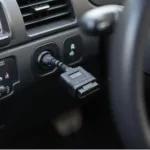OBD2 Mode 6 data offers a detailed snapshot of your vehicle’s emissions system performance. It provides valuable insights into potential issues before they become major problems, saving you time and money on repairs. This article delves into the intricacies of Mode 6, explaining its importance and how to interpret the data it provides.
Understanding Mode 6 is crucial for anyone who wants to keep their vehicle running smoothly and efficiently. It provides access to test results for components monitored by the onboard diagnostic system. These tests, conducted continuously by the vehicle’s computer, help identify potential problems within the emissions system. For example, Mode 6 can pinpoint issues with the catalytic converter, oxygen sensors, or evaporative emissions system. Using an elm327 obd2 usb can be a great way to access this data.
What is OBD2 Mode 6 Data?
OBD2 Mode 6, also known as On-Board Diagnostics Mode 6, provides access to the results of diagnostic tests performed by the vehicle’s onboard computer. This data is vital for identifying potential emissions-related problems and ensuring your car remains compliant with environmental regulations. It offers a more in-depth analysis compared to basic OBD2 codes, allowing for a more precise diagnosis.
Why is OBD2 Mode 6 Important?
Mode 6 data is critical for preventative maintenance. By identifying potential issues early on, you can address them before they escalate into costly repairs. This data allows you to monitor the health of your vehicle’s emissions system and ensure it’s operating within acceptable parameters. Early detection through Mode 6 can prevent further damage to related components, ultimately extending the life of your vehicle.
How to Interpret OBD2 Mode 6 Data
Interpreting Mode 6 data can seem complex, but breaking it down into its core components simplifies the process. Key elements include the Test ID (TID), Component ID (CID), test value, minimum limit, and maximum limit. By comparing the test value to the minimum and maximum limits, you can determine if a specific component is operating within the acceptable range.
Common OBD2 Mode 6 Tests
Mode 6 encompasses a wide array of tests, each targeting specific components and systems. Some common tests include those for the catalytic converter, oxygen sensors, evaporative emissions system, and EGR system. Understanding the purpose of each test and the implications of out-of-range values is crucial for effective diagnosis. You can even find specific information on things like obd2 mode 6 misfire.
“Mode 6 data is an invaluable tool for any serious automotive technician,” says John Smith, a certified Master Automotive Technician with over 20 years of experience. “It allows us to pinpoint problems with incredible accuracy, saving our customers time and money.”
 Mechanic Analyzing OBD2 Mode 6 Results
Mechanic Analyzing OBD2 Mode 6 Results
Using OBD2 Mode 6 for Diagnostics
Mode 6 data isn’t just about identifying existing problems; it’s also a powerful tool for predicting potential issues. By tracking trends in the data over time, you can anticipate component failures and address them proactively. This predictive capability can save you from unexpected breakdowns and expensive emergency repairs. If you are using a Toyota and require specific information, check our page on obd1 to obd2 toyota. For those interested in more advanced OBD2 interfaces, we also have information on ftdi obd2.
“Regularly reviewing Mode 6 data is like getting a regular checkup for your car,” adds Jane Doe, another experienced automotive technician. “It helps prevent small issues from becoming big headaches.”
Conclusion
OBD2 Mode 6 data provides a comprehensive overview of your vehicle’s emissions system performance. By understanding and utilizing this valuable resource, you can perform more effective diagnostics, predict potential problems, and maintain your car in optimal condition. Utilizing this information allows you to keep your vehicle running smoothly and efficiently while saving on potential repair costs. More information about misfire data can be found at obd2 mode 06 misfire data.
Need help? Contact us via WhatsApp: +1(641)206-8880, Email: [email protected] or visit us at 789 Elm Street, San Francisco, CA 94102, USA. We offer 24/7 customer support.

